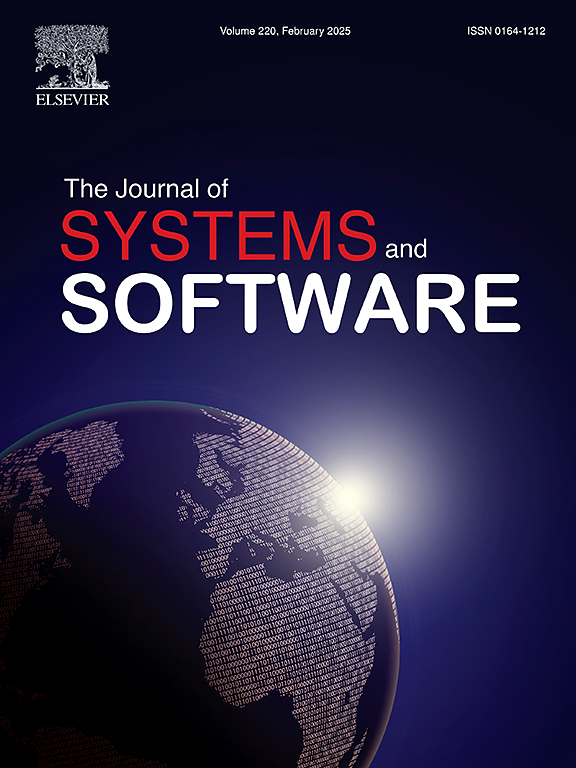通过双模变化表示学习及时预测软件缺陷
IF 3.7
2区 计算机科学
Q1 COMPUTER SCIENCE, SOFTWARE ENGINEERING
引用次数: 0
摘要
为了在早期阶段预测软件缺陷,研究人员提出了及时缺陷预测(JIT-DP)来识别代码提交中的潜在缺陷。目前流行的方法是训练模型来表示历史提交中的代码变化,并利用学习到的表示来预测最新提交中是否存在缺陷。然而,现有模型仅仅学习源代码中的版本,而不考虑更改背后的自然语言意图。这一局限性阻碍了它们捕捉更深层语义的能力。为了解决这个问题,我们引入了一种名为 BiCC-BERT 的新型双模变化预训练模型。BiCC-BERT 在代码变更语料库上进行预训练,以学习双模态语义表征。为了纳入语料库中的提交信息,我们设计了一种名为 "替换信息识别(RMI)"的新型预训练目标,它可以学习提交信息与代码变更之间的语义关联。随后,我们将 BiCC-BERT 集成到 JIT-DP 中,并提出了一种新的缺陷预测方法 - JIT-BiCC。通过利用 BiCC-BERT 的双模表示,JIT-BiCC 捕捉到了更深刻的变更语义。我们使用 27,391 次代码变更对 JIT-BiCC 进行了训练,并将其性能与 8 种最先进的 JIT-DP 方法进行了比较。结果表明,JIT-BiCC 的性能优于所有基线方法,F1 分数提高了 10.8%。这凸显了它在学习 JIT-DP 的双模语义方面的有效性。本文章由计算机程序翻译,如有差异,请以英文原文为准。
Just-in-time software defect prediction via bi-modal change representation learning
For predicting software defects at an early stage, researchers have proposed just-in-time defect prediction (JIT-DP) to identify potential defects in code commits. The prevailing approaches train models to represent code changes in history commits and utilize the learned representations to predict the presence of defects in the latest commit. However, existing models merely learn editions in source code, without considering the natural language intentions behind the changes. This limitation hinders their ability to capture deeper semantics. To address this, we introduce a novel bi-modal change pre-training model called BiCC-BERT. BiCC-BERT is pre-trained on a code change corpus to learn bi-modal semantic representations. To incorporate commit messages from the corpus, we design a novel pre-training objective called Replaced Message Identification (RMI), which learns the semantic association between commit messages and code changes. Subsequently, we integrate BiCC-BERT into JIT-DP and propose a new defect prediction approach — JIT-BiCC. By leveraging the bi-modal representations from BiCC-BERT, JIT-BiCC captures more profound change semantics. We train JIT-BiCC using 27,391 code changes and compare its performance with 8 state-of-the-art JIT-DP approaches. The results demonstrate that JIT-BiCC outperforms all baselines, achieving a 10.8% improvement in F1-score. This highlights its effectiveness in learning the bi-modal semantics for JIT-DP.
求助全文
通过发布文献求助,成功后即可免费获取论文全文。
去求助
来源期刊

Journal of Systems and Software
工程技术-计算机:理论方法
CiteScore
8.60
自引率
5.70%
发文量
193
审稿时长
16 weeks
期刊介绍:
The Journal of Systems and Software publishes papers covering all aspects of software engineering and related hardware-software-systems issues. All articles should include a validation of the idea presented, e.g. through case studies, experiments, or systematic comparisons with other approaches already in practice. Topics of interest include, but are not limited to:
•Methods and tools for, and empirical studies on, software requirements, design, architecture, verification and validation, maintenance and evolution
•Agile, model-driven, service-oriented, open source and global software development
•Approaches for mobile, multiprocessing, real-time, distributed, cloud-based, dependable and virtualized systems
•Human factors and management concerns of software development
•Data management and big data issues of software systems
•Metrics and evaluation, data mining of software development resources
•Business and economic aspects of software development processes
The journal welcomes state-of-the-art surveys and reports of practical experience for all of these topics.
 求助内容:
求助内容: 应助结果提醒方式:
应助结果提醒方式:


